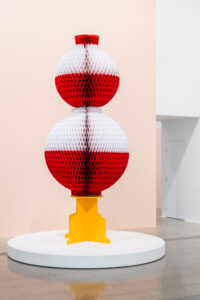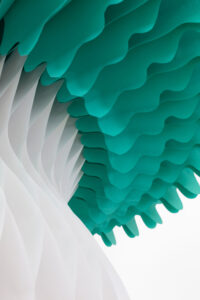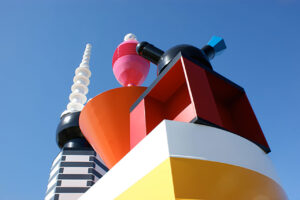Louise Paramor On Working From The Minute To The Monumental
Well known for her monumental public art commissions which often combine formal concerns with a pop-inspired sensibility, Louise Paramor’s keen sense of play and ongoing experimentation with colour, volume and scale will be on full display at Melbourne Art Fair this February. Her work will be presented as part of BEYOND, harnessing the monumental exhibition spaces within the Melbourne Convention and Exhibition Centre through the presentation of four large-scale installations and spatial interventions which respond to the Fair thematic, ketherba.
Melbourne Art Fair seized the opportunity to speak with Louise about her upcoming presentation, and her unique honeycomb paper technique.
Your presentation for BEYOND is a reworking of your ongoing series, High Society. Can you expand on how this series began and the evolution that we will see with your work at Melbourne Art Fair?
In BEYOND there will be a re-working of pieces from the High Society and the Palace of the Republic series. Both series are a result of an invitation by the NGVA to hold a survey show in 2017/18. For the latter series, in addition to showcasing earlier works, I was commissioned to make new honeycomb paper constructions that referenced an earlier period in my career. I based these new sculptures on small plastic assemblages from my Boomtown series of 2016, scaling up the elements into monumental, colourful paper forms.
The High Society series came about during COVID, where I had the idea to use up the leftover rolls of coloured paper from the NGVA show to produce a different type of series, where honeycomb paper merged with found plastic objects. The shapes and colours of the found objects, combined with the limitations of what was available in terms of the colour and quantity of paper, dictated the direction of each piece.

Louise Paramor, Palace of the Republic, 2017, archival paper, MDF, found wood and plastic objects, steel and aluminium armatures. Dimensions variable, heights range from 100cm to 400cm. Photo: Eugene Hyland. Courtesy the artist and Void_Melbourne (Naarm/Melbourne).
The outcome of your works is largely influenced by your use of different materials, with found objects dictating the shape and colour of the honey-comb paper forms. Can you elaborate on your fascination with the ‘unexpected’ aspect of your works?
The High Society series was the unexpected outcome of the Palace of the Republic series. I get very inspired when one action leads to another: without the first step, the second cannot occur or even exist as an idea. Such a process cannot be preconceived and introduces a whole other level of problem solving which I enjoy immensely.
Can you describe what is involved in your creative process when developing a new piece? How do you decide what colours and objects to pair together? What emotions or ideas are you hoping to evoke from these pieces?
I work very intuitively; it’s all about the balance of colour and form. There is no particular mood I want to inspire; mostly I just want to surprise myself and, generally speaking, with surprise comes delight. I think that intrinsically the honeycomb component of the sculptures triggers positive emotions connected to the nostalgia of decorations, which are associated with celebratory moments of the past.

Louise Paramor, High Society, 2020, archival paper, MDF, found wood and plastic objects, steel and aluminium armatures. Dimensions variable, heights range from 100cm to 400cm. Photo: Jessica Maurer. Courtesy the artist and Void_Melbourne (Naarm/Melbourne).
Your first series of honeycomb paper works were made in 1999-2000. How has your work with this specific medium evolved since then? What is unique about your technique with this material?
In the late 1990s, various types of collapsible forms fascinated me: articles that could magically transform from a flat shape into a three-dimensional object. Before employing the honeycomb paper technique, I had experimented with different collapsible forms, mostly enlarging the scale of small foil decorations, which, exhibited en masse, resulted in surreal environments.
With the honeycomb paper I found greater control, which enabled me to design my own collapsible forms, not just scale-up existing decorative objects. Honeycomb paper is made using a system of alternating lines of glue between many leaves of paper, that once cut into a shape and then pulled 360 degrees around a central axis, form a voluminous object. There was a lot of trial and error in figuring out how to make the honeycomb paper, and then a leap of faith in how far it could be pushed.
I produced the first honeycomb structures in 1999, during a one-year Australia Council Fellowship at the Kunstlerhaus Bethanien in Berlin.
The series resembled an ornate garden setting; the objects themselves not dissimilar in appearance to topiary. For this reason, I chose the title Lustgarten (Pleasure Garden), which I first noticed on a signpost near the original Lustgarten site in Berlin. The word has a nice poetry to it and the sense of the garden’s Baroque origin seemed appropriate to the opulence of the paper structures.
The more recent honeycomb paper sculptures are translations of recently made small plastic assemblages and are therefore more formal in design. They feature bright colours and also embody a nostalgia for a more recent, industrial history. It seemed logical that their series title refer to the now demolished 1970s socialist beacon, Palast der Republik (Palace of the Republic), which was situated opposite the Lustgarten in Berlin, thereby linking the naming of the new honeycomb paper series to that of the old. The sculptures which make up the Palace of the Republic series reflect a utilitarianism inherent in the parts of the original plastic objects, and are also suggestive of the dichotomy between grandeur and pragmatism.

Louise Paramor, Panorama Station (detail), 2012, Peninsula Link Freeway, painted aluminium, steel interior structure, 1700cm x 400cm x 1000xm. Photo: Louise Paramor. Courtesy the artist and Void_Melbourne (Naarm/Melbourne).
The size of each sculpture tends to compare to the human scale, evoking anthropomorphic qualities. Can you expand on the significance of scale within your works, and the relationship they have to the environment around them?
Scale is everything to me. In my practice generally, I work with a broad range of sizes, from the minute to the monumental, and every dimension in between.
The best example of the monumental in my work is the seventeen-metre high public sculpture Panorama Station, situated on the Peninsula Link Freeway. My smallest works include the Parallel Universe series, in which small architectural propositions are matched with tiny human figurines and presented as glass-boxed dioramas.
The pieces in the High Society series are roughly human-scale and this is largely to do with the domestic objects embedded within them. Mostly parts of furniture, the objects are designed for the body, therefore dictating the overall scale of the sculptures.
Louise Paramor’s work will be presented as part of BEYOND at Melbourne Art Fair this February, represented by Void_Melbourne (Naarm/Melbourne). Click here to secure tickets.


